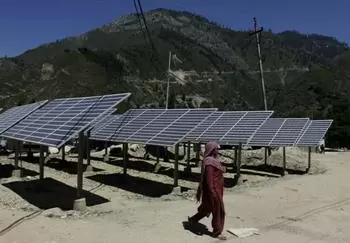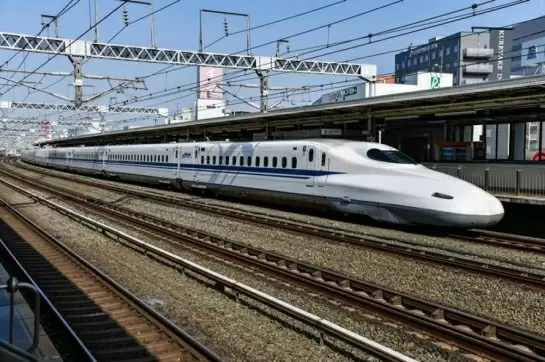To electrify all homes in India, solar power generation is a must
16-February-2015
Vol 6 | Issue 7
Currently, over 300 million Indians are without access to electricity. One of the primary reasons for poor electrification is the limited reach of the power grid. Remote locations and low incomes of the rural population however make grid extension uneconomical.
Small-scale systems can be an alternative solution. This is why the government's newly announced 100 GW solar power target under the Jawarharlal Nehru National Solar Mission (JNNSM) by 2022 includes an ambitious 20 GW from off-grid systems.
 |
|
The 20 GW target for off-grid solar power is achievable (Photo: IANS)
|
These include solar home lighting systems (SHS), solar lanterns (SLs), micro-grids and pumps. While the first two are simple to implement, they primarily only provide lighting. Micro-grids are more suitable to encourage income-generation activities.
Capital costs of solar micro-grids with storage systems are about Rs 2 lakh/kWp and the levelised cost of electricity (LCOE) is Rs. 19-24/kWh. This is high compared to Rs. 6-9/kWh for large grid-connected and rooftop PV (RTPV) systems.
It is however cheaper compared to the costs involved in extending the grid to remote areas, which varies between Rs. 26-228/kWh if the village is 5-25 km away from the grid, as shown by a Princeton University study in 2014.
Off-grid systems face major obstacles like high capital costs, poor subsidy disbursal, minimal guarantee of returns and operation and maintenance (O&M) challenges. Varying consumer locations and preferences render a generic approach unfeasible. Thus, increasing the off-grid capacity by almost 85 times (from 230 MW to 20 GW in seven years) will require meticulous planning and innovation.
Policy Gaps
Multiple decentralised electrification schemes from various ministries have led to unclear directives and mixed results. Complicated processes have led to slow capital subsidy disbursal. Streamlining the associated processes under one ministry would provide transparency and efficiency.
In the past, subsidies on diesel and kerosene made relatively more expensive solar systems economically unattractive. But with deregulated diesel prices and plans to scrap the kerosene subsidy - and the global decline in solar prices - could make solar solutions increasingly economical.
A recently proposed scheme entails giving rural households a choice between cash subsidies on kerosene or upfront capital subsidies for SHS. Once in effect, the scheme could be a game-changer for the off-grid solar sector.
Financial challenges
Established developers prefer investing in large-scale and RTPV systems because of easy access to finance, security of payment and simple O&M. Raising finance for off-grid systems is a challenge with a dearth of low interest loans. Benchmark prices of central subsidy schemes are often considerably lower than actual costs of project implementation.
This leads to disinterest in tenders. Schemes to reduce the cost of debt and increase returns on investments should be devised. Public-private partnerships with rural entrepreneurs as well as community and electricity supply company (ESCOM)/government owned projects can be encouraged.
Based on the model followed, appropriate soft loans can be availed. To encourage private developers, incentives such as tax holidays and partial risk guarantee (from the state government) can be provided. Corporate social responsibility (CSR) investments of large companies should be dedicated to off-grid projects, as they tend to have low internal rate of return (IRR).
Often, systems under capital subsidy-based models fall into disuse due to lack of long-term financial incentive. Hence, apart from interest rate subsidies, revenue models such as generation-based incentives (GBI) should be implemented.
The lack of a roadmap for rural electrification makes villagers unwilling to pay for expensive electricity in the hope that the grid will reach them. The same uncertainty makes developers reluctant to set up a system. The government should mandate that a micro-grid based system is grid-interactive and create a risk mitigation plan where developers can be compensated if the grid is extended to their area of operation.
Technical Challenges
Micro-grids need to counter intermittency. Not only does this add to the cost but also leads to maintenance issues. Innovative storage mechanisms (such as flow batteries instead of lead-acid and lithium ion technologies) and hybridising solar plants with either wind, pumped hydro or biomass can make load balancing more robust.
As skilled human resource is scarce in remote areas, O&M poses a huge concern. Local participation and capacity-building should be undertaken. Solar off-grid training programmes should be conducted in industrial training institutes and similar local bodies, which includes the 'training of trainers'.
The present lack of standardisation for micro-grid systems makes verification of designs and performance parameters uncommon. The government should establish guidelines and enforce strict quality standards for the sustainability of off-grid systems.
Effective planning of small-scale projects requires site-specific pre-feasibility analysis and assessments of local household and agricultural demands. This can lead to added expenditure but helps in checking long-term costs associated with maintenance.
If these challenges are addressed in a structured and phased manner, then the 20 GW target for off-grid solar power is achievable. Attaining success in this sector will however be an arduous task compared to grid-connected systems.
(Vaishalee Dash, Pooja Vijay Ramamurthi, Saptak Ghosh are with Bengaluru's Center for Study of Science, Technology and Policy (CSTEP). The views expressed are those of CSTEP. The authors can be reached at [email protected], [email protected] and [email protected]) - IANS















